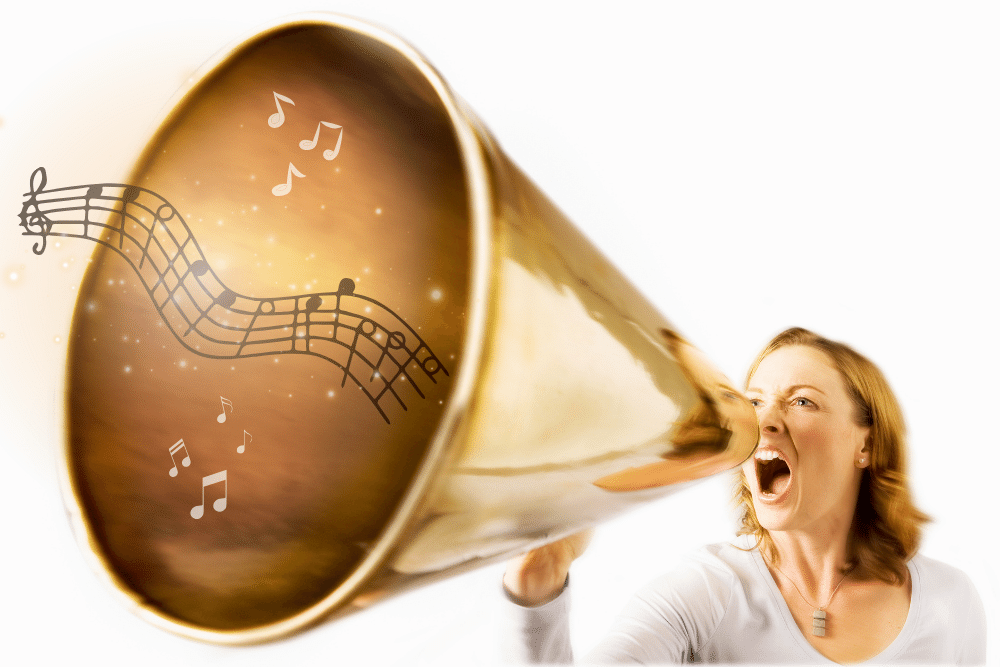
We all love music, no doubt about that. We can’t get enough of it, and I haven’t really heard of anyone who doesn’t like some sort of music. For many people it’s something that defines us and makes us tick.
But as an entrepreneur and business owner, are you tapping into the full potential of music for your digital marketing strategy in your online venture?
Music perception plays a crucial role in understanding the impact of music on consumer behavior and engagement.
A strategic approach to music can enhance branding, by leveraging the music affect to deepen consumer connections and stimulate online engagement.
It’s not something to be ignored and it’s more relevant now than ever because the use of video in online marketing has given online business owners an unprecedented opportunity. We’re able to finally exploit music to picture in the same way that TV advertising and Ad agencies have done successfully offline now for over 70 years.
Keep reading to find out how…
Grab your free
Music Strategy Starter Kit
Hey there! Just a heads-up: some of the links on this page are affiliate links. This means if you click on them and make a purchase, I might earn a small commission at no extra cost to you. I only suggest products I genuinely use and trust, or those I believe could truly benefit you. So, feel free to explore, and only grab something if you feel it's right for your needs!
Key Takeaways

So how do you go about developing a music strategy for your online business? Well there are 5 fundamentals that underpin a successful music strategy and make it work.
Let’s delve a little deeper into each of them…
1st Fundamental: Music helps to tell a story

Throughout history music has been used often with some sort of visual to help convey a message – an understanding, that works on a subconscious level. It’s unique because it’s universally understood no matter where you come from or what language you speak.
So whether it is a Wagnerian opera, a Hitchcock Movie, or an ad by Nike – music has the ability to cross the language barrier and deliver a message quickly and effectively that is understood by literally everyone in the world. So how can we use this effortless and magical storytelling ability that music has in our marketing and why does it work?
Well, Music creates a memorable ‘experience’. Often working hand in hand with dialogue and visuals it creates a smooth user experience. It complements, enhances and interacts to bring the mundane to life. Changes in musical structure, such as motifs and instrumental variations, can significantly enhance the storytelling and emotional engagement. These structural features tap into primal survival systems, creating novelty and complexity that lead to increased physiological arousal and multi-dimensional emotional experiences. It adds colour, it’s the glue that makes the whole experience work.
And the key word there is experience.
In business this musical enhancement is used to create a buying experience by tapping into the human senses. This is the secret. So if you think of this in an offline setting. On the high street as a customer, immediately when you walk through the door you’re presented the full buying experience.

Every human sense is engaged sight, hearing, touch, smell and well perhaps not taste unless of course you’re in a restaurant. But If there is an advantage that offline businesses have over online, it’s that they have more touch points to engage the customer and enhance their shopping experience.
As an online business owner we only have sight and sound to really work with, so we need to exploit these two senses to the max in order to tell the story of our business and proper use of music goes a long way to helping us do this.
2nd Fundamental: Music engages and holds attention
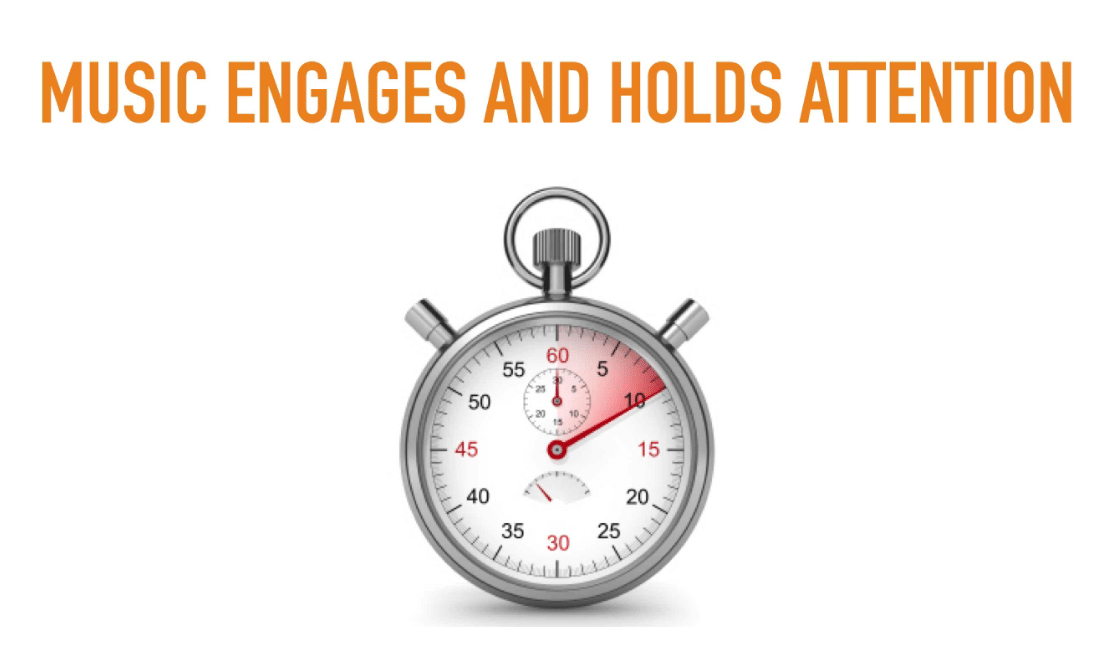
So let’s face it if you’re doing any kind of marketing online engaging your prospects is key and you only have a limited time to grab and keep their attention. With video it’s around 8 to 15 seconds but music plays a major role in keeping your audience interested beyond this initial attention grabbing phase.
So, Just think about this for a second.
Online Visual ads are easy to ignore – we come across them all the time. And they’re easy to ignore because subconsciously our brain, learns to filter out things it has experienced before and choose what’s worthy of our attention which all comes from signal detection theory and the like.
Ads with music whether offline or online, grab attention, and the way music does this is by engaging our emotions. Certain musical features, such as motif changes, instrument changes, dynamic changes in volume, and pitch, can lead to strong emotional responses, thereby holding the audience’s attention. Music listening stimulates almost every part of the brain, engaging emotions and holding attention. This is why music is so powerful, it bypasses our logical thinking mind and appeals directly to our emotions, influencing our decisions…and it’s proven that we tend to buy more things if emotion is the driving force.
Offline Ad agencies have known this for years, they know that ads with music are more likely to engage than Ads without music, not always the case but in the majority of cases this is true.
Grab your free
Music Strategy Starter Kit
3rd Fundamental: Music influences emotional reactions
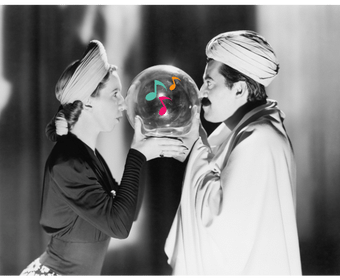
The 3rd fundamental is the most powerful and that is music’s ability to influence
As we’ve just mentioned music influences by accessing the subconscious, and directly appealing to the emotions, and that’s why Ad agencies spend thousands of dollars to get the right kind of music for their Ad campaign.
They know it’s well worth their investment when it comes to selling the final product. Music induced emotions can influence consumer behavior by triggering emotional responses that drive purchasing decisions.
No-one quite knows exactly how this influence works, but it is the mood of the music that creates the emotional response within us, and it’s something that people have been trying to understand and unravel since time began. Happy or sad music can elicit different emotional responses and impact consumer behavior by affecting various brain structures and neurotransmitter systems.
The ancient greeks pondered its effect.
Plato believed that the study of music could resolve the inherent dichotomy of the soul and have an influence upon it.
“Music is most sovereign because rhythm and harmony find their way to the inmost soul and take strongest hold upon it, imparting grace”
(Plato- The Republic)
Aristotle also believed in music’s ability to heal. Aristotle said music could help you overcome “feelings such as pity or fear’“and could “heal and purify” the soul. In fact in medicine, music has been embraced as a natural anaesthesia ever since Evan O’Neil Kane produced his report in 1914 on using a phonograph within the operating room.
And In fact what started out as an effort to cheer up traumatised American soldiers in WWII, by playing them music led to the whole medical arm of music therapy that we know today.
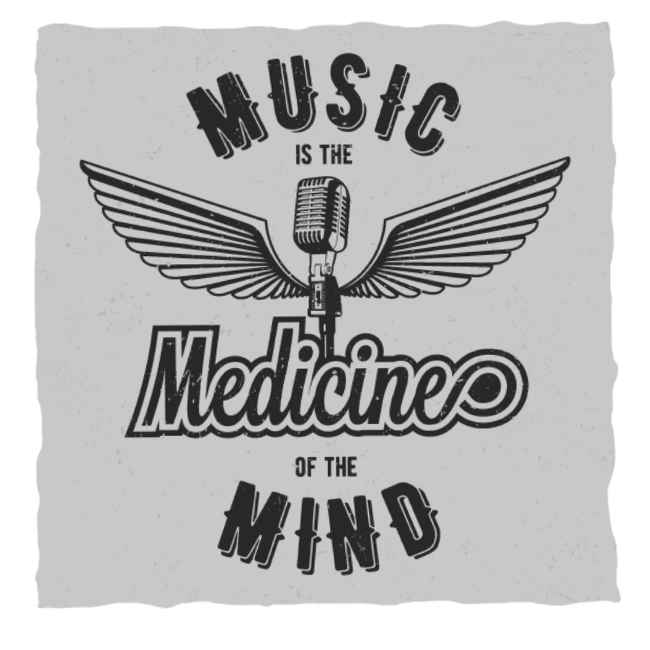
Now this isn’t a history lesson or anything but the point is that, whether it’s medicine, part of a magic act, opera, advertising or marketing, music exerts a certain influence depending on the type of music and its mood.
And If this all sounds a bit woo woo, There’ countless studies carried out that show the effect that music has on our buying habits, from the kinds of products we choose, the amount of time we spend shopping depending upon the speed or tempo of the music, and how music influences how we rate our environments and many more. Music can also elicit negative emotions, such as sadness, which can influence consumer behavior by affecting their mood and decision-making process.
Here’s an interesting and specific example involving wine.
In 1993 two members of Tech University Texas, Charles Areni and David Kim carried out what was effectively a split test, to see how certain types of background music influenced shopper’s buying habits in a wine store in a US city.
The music genres they split tested were Classical Music and the Top 40.
What they discovered was that ‘the classical music influenced shoppers to spend more money…rather than influencing patrons to purchase greater quantities of wine, the classical music actually induced them to purchase more expensive wines’. So it wasn’t quality but perceived quality that caused them to part with their money.

So why did this work. Well the classical music somehow exerted a greater influence over the wine drinker/shopper than the top 40 music did by accessing the primary emotional drive of that particular kind of shopper – the wine drinker.
The reason why it worked was because there was a match or fit between the mood the classical music suggested – one of sophistication, quality and exclusivity – with the psyche of the wine/drinker shopper. Who as the study suggested is also susceptible to feelings of sophistication and good taste. Or some may say it’s just snobbery. Take your pick!
This match between the musical mood and the shopper’s psyche resulted in a higher turnover of sales because the shopper bought higher priced wines that MIRRORED their internal mood of exclusivity, quality and perceived good taste.
Now is classical music exclusive or good taste?, well that’s down to perception and the individual.
Interestingly you don’t have to consciously agree with this perception for it to work, it all happens on the subconscious level.
The big takeaway is that if we can match the feelings or emotions of a prospect, with a corresponding music track that mirrors musical emotions and taps into that emotion, then this magnifies the message we’re trying to convey and it makes guiding the prospect to the action we want them to take a whole lot easier.
In fact interestingly this is why you often see brands like Rolex sponsoring Classical Music concerts because they are trying to push the exclusivity of their product.
Grab your free
Music Strategy Starter Kit
The 4th Fundamental – Music is the ultimate branding tool
Which leads us onto the 4th fundamental which is how music is the ultimate branding tool.
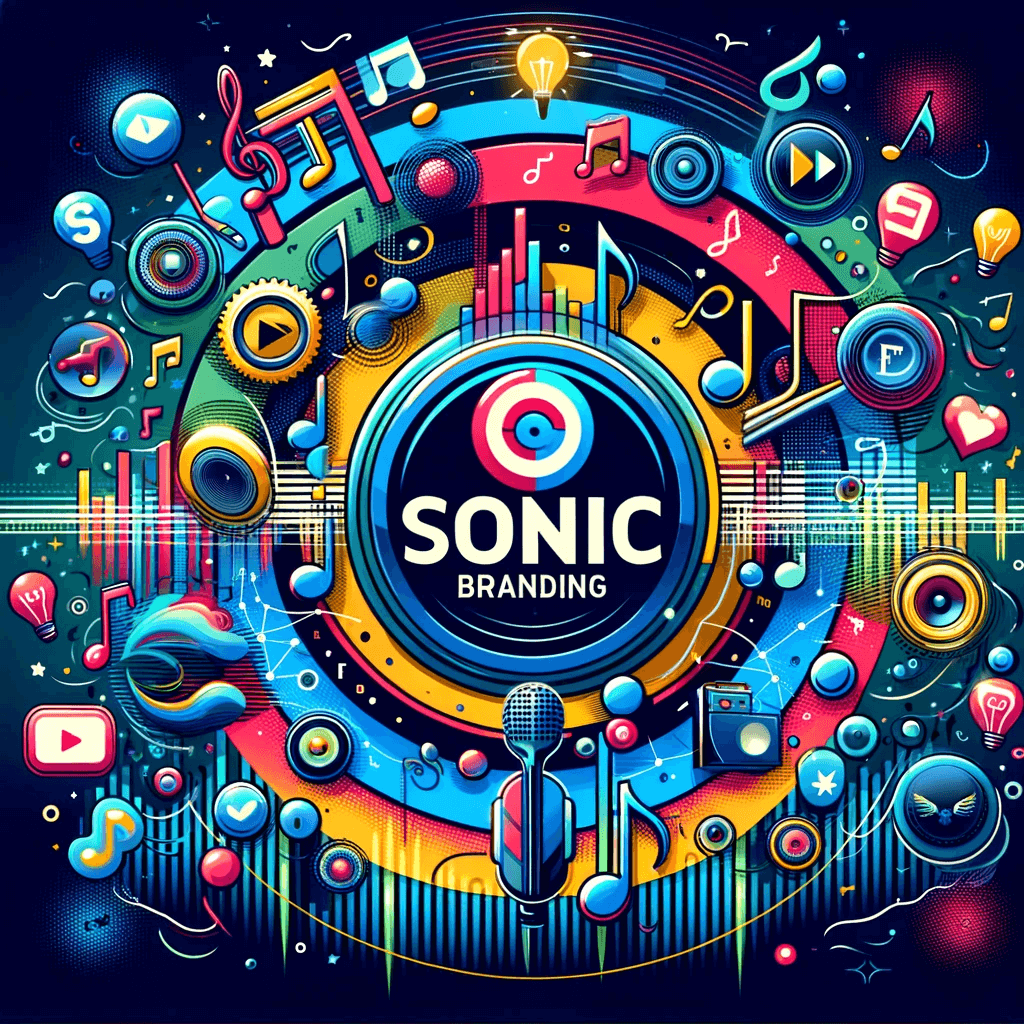
Here’s the secret that these industry marketing pros know: specific musical events, such as changes in motif and instruments, can significantly enhance brand identity and emotional engagement.
Understanding the powerful emotional responses that music can evoke, helps explain why it plays a crucial role in effective branding.
What is sonic branding?
Sonic branding (aka audio branding) relates to sound and how it reflects your brand identity and image. It’s most typically used via “jingles” – an instantly-recognisable musical piece of music or ident which binds customers with your brand. But it also relates to the musical thread and musical choice that runs through a brand’s entire marketing campaign to represent the brand experience.
This is the primary reason why leading Brands which use TV as an advertising medium pay huge amounts of money to Ad Agencies to choose and source the music that goes with their ad.
And it’s also the reason that those very same Ad agencies release a brief to invite hundreds of musicians and composers to pitch for the music on the ad, because the right music can make all the difference to the success of a campaign. And because of that they are willing to pay composers a sizeable portion of the campaign budget
The ad men know that adding a good carefully chosen soundtrack to visuals or solo commentary, will give your product credibility that otherwise would be missing. Using music that invokes the right spirit and emotional responses that your audience identifies with creates trust, and has the ability to brand your site by making it more memorable. A simple catchy ident for example can do wonders for your online branding… just think of Nokia or Intel.

In short sonic branding creates a collective brand user experience a sort of tribe mentality and identity. It says I’m part of a club with other people who understand me, are my friends, that I identify with, and make me feel great, a sort of knowing collective consciousness.
This is why music is so effective in branding a business, because it helps identify a product or service, by using sound. An ident or soundtrack gives something for the ear to latch on to which when used in conjunction with the other senses has an extremely powerful effect.
When we use music as part of the branding strategy, what we’re trying to achieve is to access the memory and subconscious of the prospective customer. The sound of the music stimulates the mind to remember any linked images, buying experience, or relationship that the customer has had with the brand. And this is why it is so important for returning customers. It makes them more receptive to the upcoming message, before they’ve seen or heard any of the content.
The GOAL of sonic branding is to re-awaken and remind the customer of those feel-good emotions and create strong emotional reactions, so that the business becomes ‘top-of-mind’ every time they hear the music you choose to use. In fact, if the music is doing its job correctly, even if the customer hasn’t used your service or product YET, they should still be curious to try.
Offline sonic branding is big business. Firms like Play Network are leading the way. They carefully construct a musical thread, experience and identity to activate and influence a Brand’s customer, in store and even after they’ve bought.
The 5th Fundamental: Music is the X-Factor of marketing

When we start to look at the role that music plays when it interacts with other parts of your marketing, we start to understand how it adds to the overall QUALITY of experience that your customer has. It’s the perfect team player and your viewers’ experience is enhanced by the quality of other key components such as the quality of the audio and the quality of the video or visuals.
Musical stimuli can enhance the overall quality of the customer experience by inducing significant physiological changes that keep the audience engaged. The multidimensional nature of musical sound, including its arousal properties and emotional quality, plays a crucial role in this engagement.
It’s this overall quality of experience that helps to increase opt-ins and conversions.
Because if the visuals, the audio quality and the music and sound design are all working together in perfect sync, they combine to do several things, all at once. The overall quality of experience produced by these elements working together is exponential. The viewer is engaged for longer – you have their full attention – because there are no distractions.
In other words it’s an enjoyable, focused, flowing experience that the consumer has, as opposed to a painful and disjointed one, and your customer then experiences a form of effortless flow. All this happens on the subconscious level without them even thinking about it. If just one thing is out of whack they’ll instinctively disengage and lose interest, often without even knowing why.
So whereas bad quality leaves room for doubt, as to the validity of your message or brand or even your professionalism. High quality of experience creates trust and confidence.
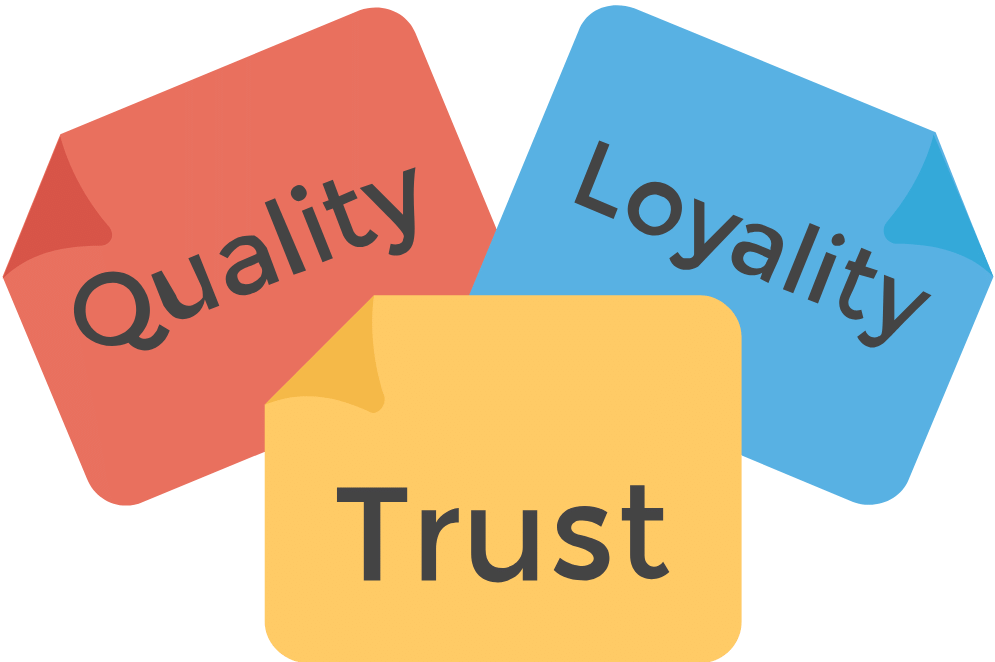
An example of how music has influenced this strive for quality is with online video. There’s a growing emphasis on the music/video partnership
It’s no accident that every memorable movie has a great soundtrack. That’s why Hollywood use composers with proven track records for potential Blockbusters, it’s just too important to leave to chance. The quality of the music and how it is used means everything.
And online, marketers, are now looking to capture the very same music quality in their own productions. And by quality I not only mean great music soundtracks but also the same crystal clear professionally recorded narrative audio, sound design and effects. No matter how well produced a video is, a poor soundtrack can bring the quality right down.
Music Increases Conversions and Opt-ins
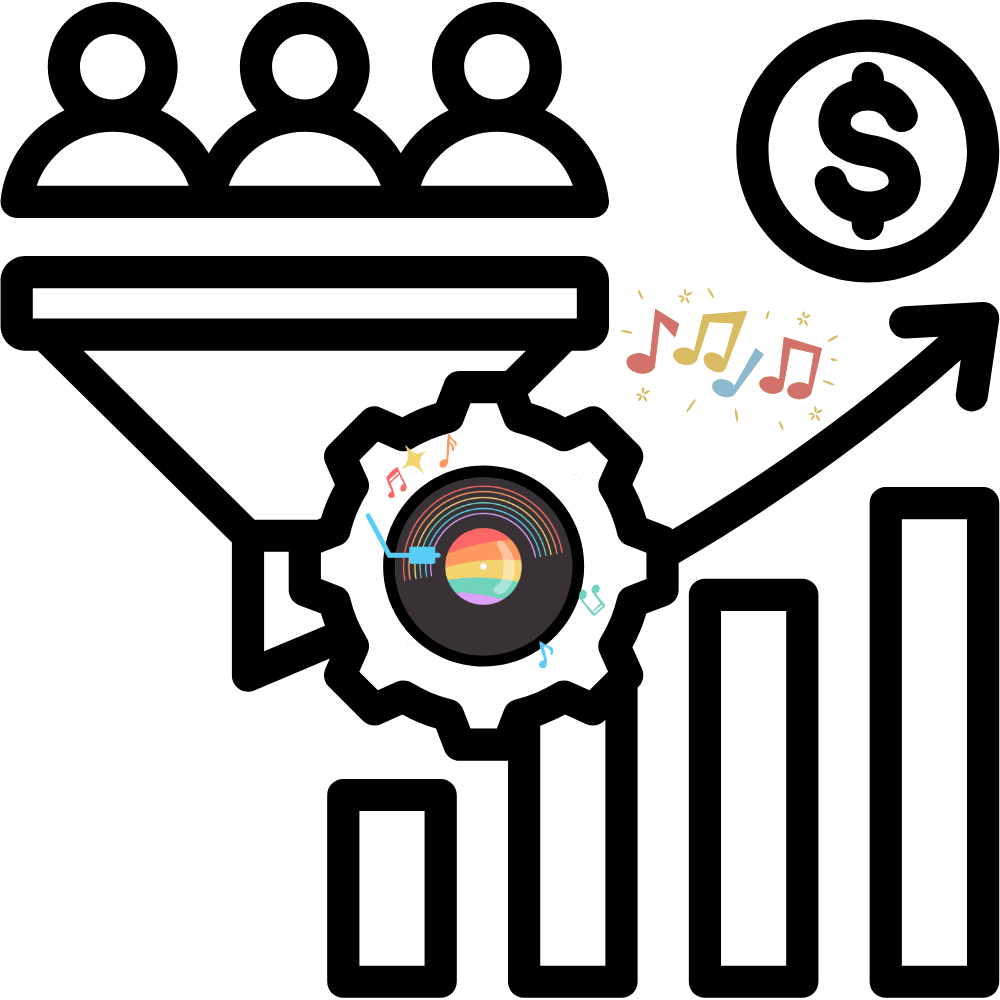
So when everything is working together this creates momentum and this is the secret to how a good music soundtrack can effortlessly move a customer or prospect through content, so they consume it easily, and end up taking the action you want them to take.
Pleasant music can elicit positive emotional responses, driving consumer actions by engaging brain regions connected to positive emotions that is most effective accompanying call to actions (CTAs) or point of sale.
So, when you tap into the subconscious of your customer it’s easy to get them from point A to point B, and since most CTAs are at the end of content, then music is a superb vehicle for getting your prospect to that point. The more people who see that CTA the better your conversions are going to be.
Grab your free
Music Strategy Starter Kit
Conclusion and Summary
So some of these concepts may seem a bit out there at first. If you’ve never considered how music tells a story, engages or influences then this may come as bit of an eye opener.
But the big takeaway is that all these subconscious musical triggers are proven, and have been tried and tested over decades in many kinds of offline advertising and numerous studies.There’s no need to reinvent the wheel, we just need to incorporate these proven offline methods into our online marketing.
Frequently Asked Questions
What is branding in music?
Branding in music, often referred to as sonic branding or audio branding, is the strategic use of sound to reinforce brand identity and enhance customer connection. This can be achieved through the use of specific melodies, jingles, sounds, or even the consistent use of a particular genre or style of music that resonates with the brand’s image. The goal is to create a unique auditory signature that consumers can immediately recognize and associate with the brand.
What is meant by sonic branding?
Sonic branding, also known as audio branding, is a marketing strategy that uses distinctive, consistent sounds to help establish and reinforce a brand’s identity. These sounds can be anything from a jingle, a specific melody, a set of notes, the sound a product makes, or even a particular voice. The goal is to create an auditory signature that is instantly recognisable and immediately associated with the brand, enhancing brand recall and customer connection.
What is the power of Sonic branding?
Sonic branding wields immense power due to its unique ability to forge an emotional and psychological connection with consumers. It taps into our innate response to sound, bypassing rational thought and directly influencing our feelings and behaviors. This makes it a potent tool for brand recall and recognition.
When a brand’s sonic identity is consistently used across various touchpoints, it reinforces the brand’s identity and can trigger specific emotions or memories associated with the brand. This can lead to increased customer loyalty and engagement, as customers form a deeper, more personal relationship with the brand.
Moreover, in today’s digital age where visual overload is common, sonic branding stands out as a distinct and memorable way to capture consumer attention. It also has the advantage of being versatile and adaptable across various platforms – from TV commercials and radio ads to digital ads, podcasts, and even product sounds.
In essence, the power of sonic branding lies in its ability to enhance brand identity, evoke emotional responses, improve brand recall, and ultimately, drive customer loyalty and engagement.
What is the best example of sonic branding?
The best example of sonic branding is McDonald’s with their “I’m Lovin’ It” jingle, Apple’s startup sound, Amazon’s Alexa voice, and Microsoft’s Windows startup sound. These are commonly referred to as ‘audio logos’.
Why use audio branding?
Audio branding, also known as sonic branding, is a powerful tool for businesses to establish a unique identity and create a strong emotional connection with their audience. Here are some reasons why you should consider using audio branding:
- Memorability: Sound is incredibly memorable. A distinctive audio logo or jingle can make your brand instantly recognizable to your audience.
- Emotional Connection: Music and sound have the ability to evoke strong emotions. By associating your brand with a specific sound or piece of music, you can influence how people feel about your brand and create a deeper emotional connection.
- Stand Out in the Crowd: In a world saturated with visual content, audio branding can help your brand stand out from the competition.
- Consistency Across Platforms: An audio brand can be used across all platforms and touchpoints, providing a consistent brand experience whether your audience is interacting with your brand on a website, social media, radio, or television.
- Enhances Brand Personality: The type of sounds or music you choose can communicate your brand’s personality and values, helping to attract your target audience.
What is sound marketing strategy?
A sound marketing strategy refers to the strategic use of audio elements to enhance a brand’s identity, improve customer engagement, and drive marketing outcomes. This could involve elements such as jingles, theme music, voiceovers, sound effects, and other audio cues.
The strategy involves careful selection and consistent use of these audio elements across various marketing channels to create a unique sonic identity. This sonic identity can help to differentiate a brand, evoke specific emotions in customers, enhance recall, and create a more immersive and memorable brand experience.
A sound marketing strategy is built on understanding your brand’s identity, your target audience, and the kind of emotional response you want to evoke. It requires careful selection of the audio elements that align with these factors, and their consistent application across all your marketing efforts.
How can I develop a music strategy for my online business?
Developing a music strategy for your online business involves several steps:
- Understand Your Brand: The first step is to understand your brand’s identity, values, and message. What kind of emotions do you want your brand to evoke? This will guide your choice of music.
- Know Your Audience: Understand your target audience’s preferences, habits, and tastes. The music you choose should resonate with them and enhance their connection with your brand.
- Choose the Right Music: Based on your brand identity and your audience’s preferences, choose music that aligns with these factors. This could be a specific genre, a particular mood, or even a unique sound.
- Consistency: Use the chosen music consistently across all your online platforms. This includes your website, social media, ads, videos, and any other online presence you have
- Measure and Adjust: Monitor the impact of your music strategy on your business outcomes. Are you seeing increased engagement? Higher conversion rates? Use this data to tweak your strategy as needed.
Remember, your music strategy should be an integral part of your overall marketing strategy, reinforcing your brand identity and enhancing your customer’s experience.